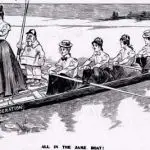
The origins of Australia’s constitutions are intertwined with our unique national history. In comparison to other countries, Australia is a relatively young nation. The Commonwealth of Australia was formed by our federation in January 1901. Prior to Federation, the Australian continent contained several British colonies (the forerunners of our modern States). During the 19th century, political authority and law-making power in these colonies rested with the British Crown and the parliament at Westminster. But the vast distances between England and Australia made it impossible for the British parliament to make all laws for the colonies.
During the early colonial period in Australia, most law-making was left to various governors. These individuals were appointed by Britain and became the Crown’s representative in their respective colonies. Colonial governors wielded a great deal of power. Their decisions could only be overruled by ministers of the Crown back in London. Eventually, Australia became populated and settled, and its people began to show an interest in self-government. Beginning in the early 1800s the British government moved toward responsible government by passing a series of acts. The first of these, the New South Wales Act (1823), established a Legislative Council and the Supreme Court in that colony. The New South Wales Act is viewed by many as Australia’s first constitutional document. In 1842 the British parliament passed the New South Wales Constitution Act, which allowed some democratic representation in the New South Wales legislature.
In 1850 the British parliament passed the Australian Constitutions Act, which allowed the four colonies then in existence – New South Wales, Victoria, Tasmania and Western Australia – to establish their own parliaments and responsible government, once certain conditions had been fulfilled. Eventually, the Parliament of Westminster passed a constitution for each of the Australian colonies:
- New South Wales (1854)
- Victoria (1855)
- Tasmania (1855)
- South Australia (1856)
- Queensland (1867)
- Western Australia (1890)
For a time the six colonies operated with a degree of autonomy and self government. In the last quarter of the 19th century, however, shifting conditions and perspectives saw the rise of new ideas about Australia. Increased migration, the Gold Rush of the 1850s, the growth of Australian cities and rising fears about foreign invasion began to change the way Australian colonists saw themselves. Many began to support the idea of a federation: the joining together of the various colonies to form a strong national government, capable of protecting and advancing Australian interests. Some of the reasons given for federation included:
Defence. In the mid to late 1800s many parts of colonial Australia were plagued by fears of foreign aggression or invasion. France was a traditional rival of Britain and had naval reserves capable of landing in or attacking Australia; Germany had expanded into the Pacific, seizing several islands and part of New Guinea as colonial possessions; Russia was another British rival and also had a naval force in the Asia-Pacific region. In reality there was little or no danger of Australia coming under attack, however this paranoia fuelled calls for a strong defence force, supplied and managed by a national government.
Trade. Late 19th century Australia was beset with problems affecting its internal and external trade. Colonial governments sought to protect their own economies by limiting or blocking imports from other colonies. They passed regulations and imposed tariffs and customs duties, requiring border checks and enforcement. Many also believed that Australia’s trade with foreign nations would be better served by a national government, rather than self-serving colonial governments.
Consistency. Lack of consistency in the laws and practices of different colonies was another factor. Relations and trading between the colonies were encumbered by a lack of consistency or standards, such as differences in criminal law and the use of different rail gauges. The latter made transport across colonial borders difficult, with passengers and cargo having to change trains.
Currency. One financial hurdle was the lack of a single national currency. Colonial governments, banks and merchants issued their own currencies, as well as using foreign currencies such as British pounds. These different currencies all fluctuated and varied in value, which made intercolonial trade and financial transactions difficult and confusing.
The Federation movement rose to its peak in the 1890s. A draft constitution was constructed in 1891 and a constitutional convention was held in 1897-8. The men who drafted the Federal constitution wished to maintain most of the conventions of the Westminster system, however, they also looked to the United States Constitution, which had succeeded in uniting thirteen states into one federal union. Their draft was presented at a referendum to the voters in five of the six colonies (Western Australia abstained) before being sent to England for the approval of the British parliament. It was passed there as the Commonwealth of Australia Constitution Act 1900, with its enactment scheduled for January 1st, 1901. The Commonwealth of Australia, its parliament and High Court were formally created on that day. The six colonies became States and retained their own State governments and court systems.
© lawgovpol.com 2014. Content on this page may not be republished or distributed without permission. For more information please refer to our Terms of Use.
